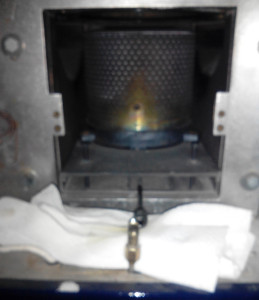Time for a bit of DIY Aga servicing.
Some years ago I was taught how to service our oil Aga by a friendly, Austin Seven driving, ex-Aga installer. The process, once you know it, isn’t complicated, but it does cost over £100 these days to have someone come and do it for you. This is made worse by the fact that oil is apparently getting dirtier, so a once or twice a year service now needs doing two or three times a year.
This is how easy it was:
The first picture is the heater unit in the Aga. Simply switch off the oil supply, undo the oil supply pipe, and remove the unit. The second picture is of the burner outside and the third shows the underside. The oil supply pipe has been removed and a drill is used to clean through to the burner reservoir.
The next picture below shows the oil well and wicks, of which there are two. There is a crusting of oil residue in the well. I try to service the burner when it is like this, mildly crusted. I have however, missed a servicing in the past and found the well crusted solid with almost no space for the oil to flow.
The second picture shows the amount of residue scraped out from the reservoir. The third is of new wicks. I replace the wicks every 4 years or so and it was time.
A simple clean of the baffles with a wire brush later and the job is done.
Unfortunately, I forgot to take a picture of the cylindrical baffles being cleaned, but they are basically just metal perforated tubes. Push them back in place and the unit is read to go back into the Aga.
Switch the oil back on and leave for about an hour, to make sure that the oil has soaked the new wicks, and it is ready to light.
So that’s about 30 minutes for the service, an hour of waiting time, and £100 saved.
This post comes with all usual disclaimers. It is not a complete guide to servicing an oil Aga burner, rather the highlights of how I do it. I wouldn’t have done this without the opportunity to watch a qualified Aga engineer do it first, and neither should you.






